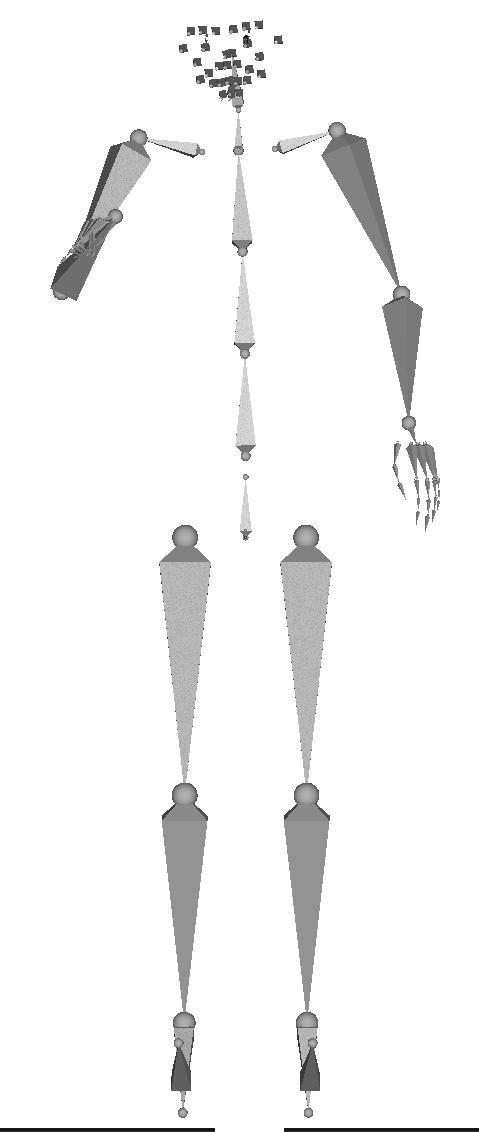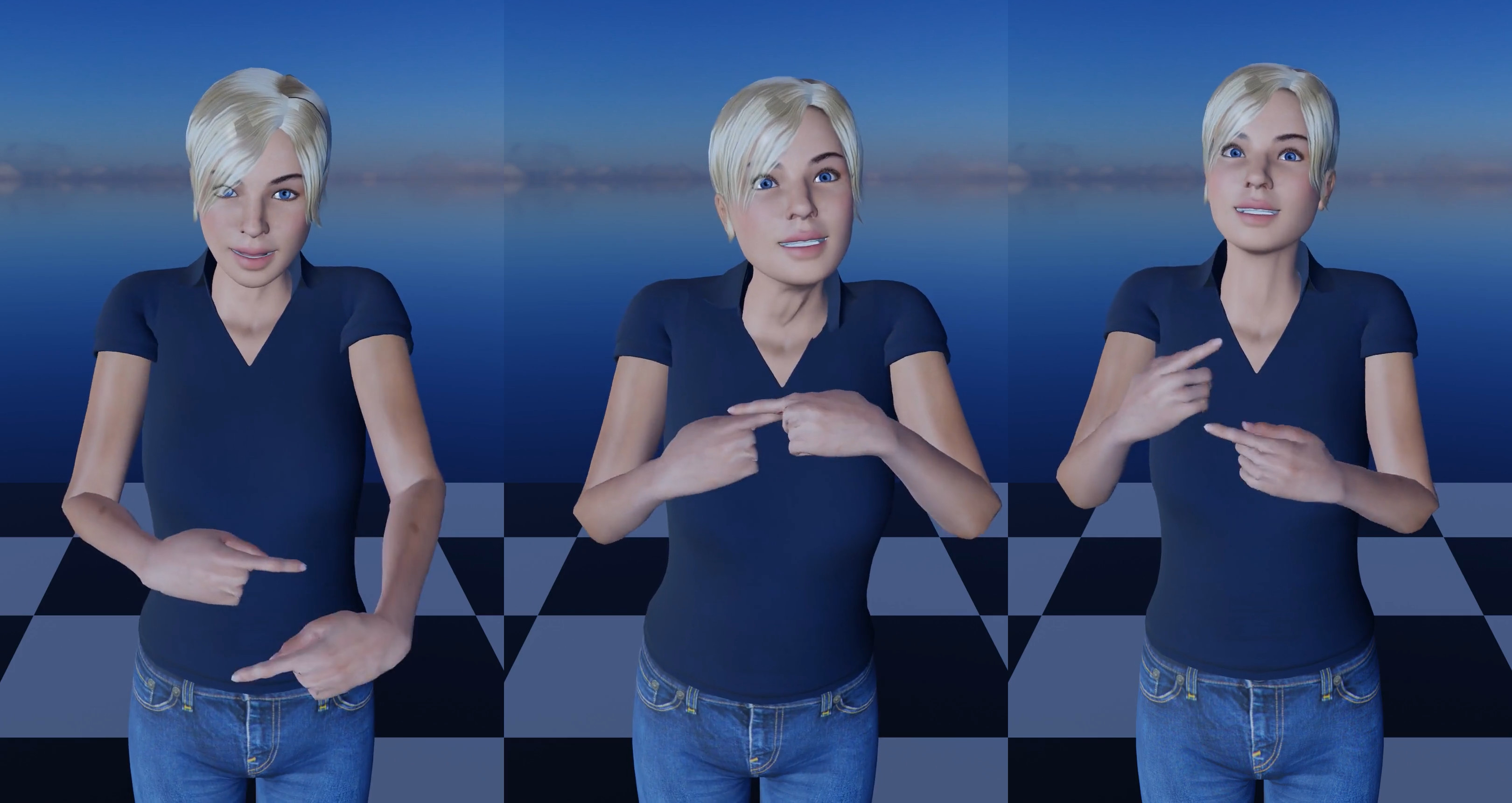Master Thesis Defense
Inflection of Sign Language Manuals and Non-manuals of the body via Rigid Geometrical Transformations
- Press "space" to navigate forward (also can use arrow keys.)
- Press "t" to play 3D animations. Yes, it is 3D animation not just video.
- You can use your mouse to change the camera angle in 3D animation.
- You can use scroll wheel to zoom in and out in 3D animation.
- You can change the page zoom by pressing "ctrl" and "+" or "-" keys to adjust the presentation.
- Best viewed in Chrome or Chromium based browsers.
Master Thesis Defense
Inflection of Sign Language Manuals and Non-manuals of the body via Rigid Geometrical Transformations
23-11-2023
Primary Advisior: Dr. Fabrizio Nunnari [2]
Examiner: Dr. Patrick Gebhard [2]
Supervisor: Prof. Dr. Antonio Krüger [1][2]
[1] Saarland University, [2] DFKI, German Research Center for Artificial Intelligence, Cognitive Assistants, Affective Computing Group
What is Sign Language?
"Inflection"
The person go home
The person go home
The person is going home
Inflection in Sign Language
(press "t" to play 3D animation)
A sign is being used in citation (dictionary) form. Now the same sign is used in inflected form Contextualized gloss: NICHT
Why are the current systems built like this?
(press "t" to play 3D animation)
(Heute bis auf Weiteres kein Zugverkehr) Non Inflected Sentence Original Sentence Motion capture data is hard to modify!
It is impossible to capture all combination of inflections
What is the State of the Art?
Manual/Procedural Animation Generation
Simax [1]

JASigning[2]
Current avatar animation system
[1] SiMAX, The Sign Language Avatar System [2] Elliott, R., Bueno, J., Kennaway, R., and Glauert, J. Towards the Integration of Synthetic SL Animation with Avatars into Corpus Annotation Tools: 4th Workshop on the Representation and Processing of Sign Languages.
End-to-End Deep Learning Based Animation Generation

End to end animation generation [1]

Progressive Transformers [2]
[1] sign.mt
[2] Saunders, Ben, Necati Cihan Camgoz, and Richard Bowden. "Progressive transformers for end-to-end sign language production." Computer Vision–ECCV 2020: 16th European Conference, Glasgow, UK, August 23–28, 2020, Proceedings, Part XI 16. Springer International Publishing, 2020.
Motion Capture Based Approach

Animation generated using Motion Capture and Motion Elements [1] [2]
[1] Gibet, S., Courty, N., Duarte, K., and Naour, T. L. The signcom system for data-driven animation of interactive virtual signers: Methodology and evaluation. Ksii Transactions on Internet and Information Systems (2011).
[2] Gibet, S., Lefebvre-Albaret, F., Hamon, L., Brun, R., and Turki, A. Interactive editing in french sign language dedicated to virtual signers: requirements and challenges. Universal Access in the Information Society (2015).
Vector Based Model

Animation using Vector Based Model [1][2]
[1] Lu, P., & Huenerfauth, M. (2012, June). Learning a vector-based model of American Sign Language inflecting verbs from motion-capture data. In Proceedings of the Third Workshop on Speech and Language Processing for Assistive Technologies (pp. 66-74).
[2] Huenerfauth, M., Lu, P., & Kacorri, H. (2015, September). Synthesizing and evaluating animations of American sign language verbs modeled from motion-capture data. In Proceedings of SLPAT 2015: 6th Workshop on Speech and Language Processing for Assistive Technologies (pp. 22-28).
Prosody Based Methods
[1] Adamo-Villani, N., & Wilbur, R.B. (2015). ASL-Pro: American Sign Language Animation with Prosodic Elements. Interacción.
Timing Inflection


[1] De Martino, J. M., Silva, I. R., Bolognini, C. Z., Costa, P. D. P., Kumada, K. M. O., Coradine, L. C., ... & De Conti, D. F. (2017). Signing avatars: making education more inclusive. Universal access in the information society, 16, 793-808.
Our contribution
Increment on the motion capture based System
Introduction to Inflection Parameters
Parameters of functions that transform animation data of a sign to contextulize it
Classification of the Inflections
[1] Nunnari, F., Mishra, S., & Gebhard, P. (2023, June). Augmenting Glosses with Geometrical Inflection Parameters for the Animation of Sign Language Avatars. In 2023 IEEE International Conference on Acoustics, Speech, and Signal Processing Workshops (ICASSPW) (pp. 1-5). IEEE.
Classification of the Inflections
Simplified Ideas
Input Data
Gloss: NICHT

Input data (Source)
Dictionary

Target Data (Target)
Sentence
Trajectory Matching
Goal: Minimize the error
Error: L2-norm
Error: 0
Computation of Average Orientation Delta
Computation of Average Translation Offset
Mathematical Formulation
Computation of Shoulder, Torso and Head Parameters

Shoulders
\[ \begin{aligned} \vec{\Delta}_{Sh} &= \frac{1}{N}\sum^{N} |\vec{X_{t}} - \vec{X_{s}}| \end{aligned} \]
Head
\[ \begin{aligned} \vec{\theta}_{He} &= \vec{R_{s}}^{-1}\vec{R_{t}}\\ \end{aligned} \]


Torso
\[ \begin{aligned} \vec{\Delta}_{T} &= \frac{1}{N}\sum^{N} |\vec{X_{t}} - \vec{X_{s}}| \end{aligned} \]
\[ \begin{aligned} \vec{\theta}_{T} &= \vec{R_{s}}^{-1}\vec{R_{t}}\\ \end{aligned} \]
Orientation
\[ \begin{aligned} \vec{\theta}_{Ha} &= \vec{R_{s}}^{-1}\vec{R_{t}}\\ \end{aligned} \]
Trajectory
\[ \begin{aligned} \text{Translation}, \vec{T} & = (t_{x}, t_{y}, t_{z})^{T}\\ \text{Rotation}, \vec{R} & = (\theta_{x}, \theta_{y},\theta_{z})^{T}\\ \text{Scale}, \vec{S} & = (s_{x}, s_{y}, s_{z})^{T} \end{aligned} \]
\[ \begin{aligned} \text{Error}, E = \arg\min_{\vec{T}, \vec{R}, \vec{S}} \left\| \vec{X}_{t} - \vec{X}_{s}^{'} \right\|_{2} \end{aligned} \]

Architecture: Online Sentence Generator
























Animation Result
(press "t" to play 3D animation)
(Heute bis auf Weiteres kein Zugverkehr)
Non Inflected Sentence
Inflected Sentence
Original Sentence
Quantitative Results
Metric One: Mean Per Joint Position Error (MPJPE)
$$ \begin{aligned} E_{\text{MPJPE}} = \frac{1}{N} \sum_{i=1}^{N} \| p_{\text{pred}}(i) - p_{\text{gt}}(i) \|_2 \end{aligned} $$
Metric Two: Mean Per Joint Angular Error (MPJAE)
$$ \begin{aligned} E_{\text{MPJAE}} &= \frac{1}{3N} \sum_{i=1}^{3N} \left| m_{\text{pred}}(i) - m_{\text{gt}}(i) \mod \pm 180 \right| \end{aligned} $$
Metric Three: Normalized Power Spectrum Similarity (NPSS)
$$ \begin{aligned} NPSS &= \frac{\sum_{i} \sum_{j} p_{i, j}*\textrm{emd}_{i,j}}{\sum_{i} \sum_{j} p_{i, j}}\\ \end{aligned} $$
Qualitative Result
Preliminary User Study
Experts ($N = 6$) who are fluent in German Sign Language


Naturalness

Grammatical Correctness

Understandability
User Study: Naturalness
User Study: Understandability
User Study: Grammatical Correctness
Key Observation
- No facial data
- Timing of playback
- Extreme torso movements

Limitations
Timing Issue
(press "t" to play 3D animation)
(Heute bis auf Weiteres kein Zugverkehr)
Glosses with Resampled Duration
Glosses with Original Duration
Complicated Trajectories

Self Collisons

Future Work
Trajectory Transitions
